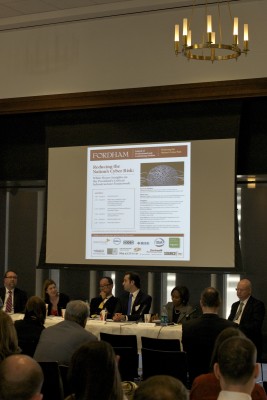Fordham Brings White House Officials to Discuss Cybersecurity
March 13, 2014

President Barack Obama recently issued an executive order establishing a national framework to limit the cyber threat to the country’s critical infrastructure. On March 11, Fordham College at Lincoln Center (FCLC) held a free information session in the 12th Floor Lounge, featuring senior White House officials to explain the impact of the president’s new policy.
Noting that Fordham will offer a master’s program in cybersecurity launching in fall 2014, the moderator, Michael Coden, vice president of the New York Section of the International Society of Automation, called the president’s policy “a guideline to economical and safe cyber security practices.”
Upon leaving her job as a technology and cybersecurity advisor in the Department of Energy, Samara Moore, the keynote speaker, took the job as Director for Cybersecurity Critical Infrastructure Protection in the White House National Security Staff.
Moore worked with President Obama on the new policy to reduce cyber attacks to critical infrastructure, the systems and assets so vital to the United States that the “destruction of such systems and assets would have a debilitating impact on security, national economic security, national public health or safety,” according to the White House.

Explaining the purpose of the event, Moore said, “We are here because cyber threats pose a risk to economic security. Cyber risk has the potential to drive down our bottom line.”
She noted three major trends in cybersecurity: (1) the threat is becoming broader, (2) the threat is becoming more sophisticated, and (3) the threat is becoming more dangerous.
“Malware is becoming more of a target, becoming more available to the bad guys. It can morph. It’s easier to access,” Moore said. She’s also concerned about unintentional cyber threats: “We must have an incidence response plan, a continuity plan.”
Jenny Menna, director of Stakeholder Engagement and Cyber Infrastructure Resilience at the Department of Homeland Security, spoke about the impact the President’s new policy will have on information sharing.
Jon Boyens leads the cybersecurity division at the National Institute of Standards and Technology. He listed and explained the five main parts of the new national framework’s core: Identify, Protect, Detect, Respond and Recover.
Two Fordham faculty members also sat on the panel: Frank Hsu, professor of computer and information science, and David J. Youssef, teaching fellow in the department of computer and information science.








